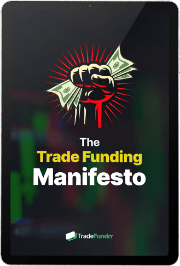Copyright 2023, TradeFundrr. All Rights Reserved.
*It is our mission to successfully fund an average of 20 qualified traders per month, starting with a minimum of $100,000 in funding per trader and growing to as much as $10,000,000 in funding for those traders that prove themselves through performance. For an aggregate amount of funding deployed of 1 billion dollars by year-end 2030. Funding provided is buying power (in the real market, NOT simulated) by T3 Global Group, LLC,(“T3G) an affiliate of T3 Companies. Funding is conditional on meeting the stipulated simulated performance goals provided by TradeFundrr, LLC and meeting the eligibility requirements set forth by “T3G” in its sole discretion.
+Users qualifying for Retail Trader Funding from authorized countries who follow their selected qualification rules are eligible to earn performance-based payouts on simulated trading performance. All trading is executed in a simulated account provided by TradeFundrr, LLC with the payout being based on simulated performance (performance-based trading). Real-money payouts are contingent on the user’s trading performance adhering to the stipulated risk management and performance rules of the TradeFundrr, LLC “Pre-Prop Account” sim trading account. For specific details on how this pertains to you, refer to your partner program for additional information. Distribution of the payout earned in the simulated account can be distributed to the trader at the trader’s sole discretion. A trader may elect to transfer some or all their simulated profits to the live money prop account to increase their max available drawdown. Traders who are not successful in the live-money prop account will be ineligible to reapply unless they make a capital contribution.
** A high-performance trader means any qualified Futures, Options, and Stock Retail traders and Pro Trader Traders, who prove themself through exceptional risk management and consistent profit-taking in their selected Asset Class. Funding provided is buying power (in the real market, NOT simulated) by T3 Global Group, LLC,(“T3G) a Unit of T3 Companies. Funding is conditional on meeting the stipulated simulated performance goals provided by TradeFundrr, LLC, and meeting the eligibility requirements set forth by T3G in its sole discretion.



